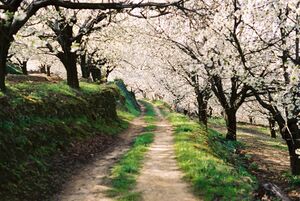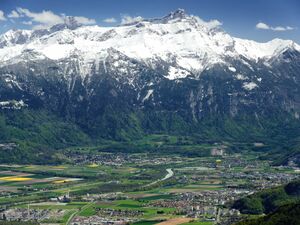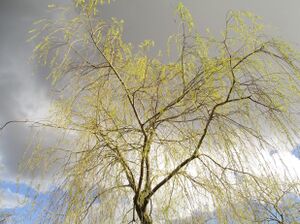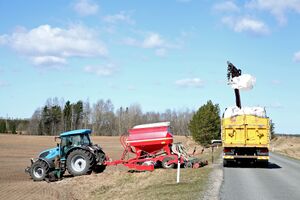ربيع
| Temperate season | |
|---|---|
 | |
| Northern temperate zone | |
| Astronomical season | 21 March – 21 June |
| Meteorological season | 1 March – 31 May |
| Solar (Celtic) season | 1 February – 30 April |
| Southern temperate zone | |
| Astronomical season | 23 September – 22 December |
| Meteorological season | 1 September – 30 November |
| Solar (Celtic) season | 1 August – 31 October |
| الصيف الربيع الشتاء | |
| جزء من سلسلة الطبيعة عن |
| الطقس |
|---|
 |
|
|
الربيع أو فصل الربيع و أحد الفصول الأربعة في المناطق المعتدلة، ويأتي بعد الشتاء ويليه الصيف. هناك العديد من التعريفات التقنية للربيع، ولكن الاستخدام المحلي للمصطلح يختلف حسب المناخ والثقافات والعادات المحلية. وعندما يحل الربيع في نصف الأرض الشمالي، يحل الخريف في نصف الأرض الجنوبي والعكس صحيح. مع حلول الربيع (أو عند حدوث الاعتدال الربيعي، يصبح طول النهار تقريبًا 12 ساعة، ويزداد مع مرور الفصل وبالتالي تقل عدد ساعات الليل.
تشير كلمتا الربيع وفصل الربيع إلى الفصل وأيضًا فكرة الولادة من جديد، واستعادة الشباب، والتجديد والبعث والنمو من جديد. وفي هذا الوقت يصبح مناخ المناطق شبه الاستوائية والمناطق الاستوائية أفضل مقارنة بالفصول الأخرى، سواء كان المناخ في الفصول الأخرى جاف أو رطب، هناك رياح موسمية أو أعاصير. قد تكون لدى الثقافات الأخرة أسماء محلية للفصول تختلف بعض الشئ عن المسميات ذات الأصول الأوروبية.
. . . . . . . . . . . . . . . . . . . . . . . . . . . . . . . . . . . . . . . . . . . . . . . . . . . . . . . . . . . . . . . . . . . . . . . . . . . . . . . . . . . . . . . . . . . . . . . . . . . . . . . . . . . . . . . . . . . . . . . . . . . . . . . . . . . . . . . . . . . . . . . . . . . . . . . . . . . . . . . . . . . . . . . .
التعريف المناخي
يحدد خبراء الأرصاد الجوية أربعة فصول في العديد من المناطق المناخية: الربيع، الصيف، الخريفن الشتاء، ويتم تحديد تلك الفصول حسب متوسط درجات الحرارة بالمعدل الشهري، ويدوم كل فصل ثلاثة أشهر؛ الثلاثة الأكثر ارتفاعًأ في درجات الحرارة يطلق عليهم الصيف، والثلاثة الأكثر انخفاضًا في درجات الحرارة يطلق عليهم الشتاء ويتخلل الفترات بينهم كل من الربيع والخريف. وتختلف التواريخ التي يبدأ فيها الربيع مناخيًا حسب كل منطقة.
في الولايات المتحدة والمملكة المتحدة، يحل الربيع في مارس ويستمر في إبريل ومايو.[1][2]
في أستراليا،[3] ونيوزيلندا،[4][5] يبدأ الربيع في سبتمبر وينتهي في 30 نوفمبر.
في إيرلندا، يدوم الربيع وفقًا إلى التقويم الگاليكي، شهر فبراير ومارس وإبريل.[6][7]
في السويد، يحدد خبار الأرصاد الجوية بداية الربيع عندما يتجاوز متوسط درجة الحرارة 24 ساعة درجة صفر مئويًا ولمدة سبعة أيام متتالية، وهكذا يختلف تاريخ الربيع باختلاف خطوط الطول والعرض.
في البرازيل، شهور فصل الربيع هي سبتمبر وأكتوبر ونوفمبر وديسمبر.
التعريف الفلكي والشمسي
في العديد من الثقافات شمال الكرة الأرضية (مثل: ألمانيا والولايات المتحدة وكندا والمملكة المتحدة)[8]) يمثل الاعتدال الربيعي (الذي يكون بين فترة 19 و21 مارس) أول أيام الربيع ويمثل الانقلاب الصيفي (21 يونيو) أول أيام الصيف. في التقاليد الأخرى، يتم يمثل الانقلاب الربيع منتصف الربيع.
In Persian culture the first day of spring is the first day of the first month (called Farvardin) which begins on 20 or 21 March. In the traditional Chinese calendar, the "spring" season (春) consists of the days between Lichun (3–5 February), taking Chunfen (20–22 March) as its midpoint, then ending at Lixia (5–7 May). Similarly, according to the Celtic tradition, which is based solely on daylight and the strength of the noon sun, spring begins in early February (near Imbolc or Candlemas) and continues until early May (Beltane).
The spring season in India is culturally in the months of March and April, with an average temperature of approx 32 °C.[9] Some people in India especially from Karnataka state celebrate their new year in spring, Ugadi.
Ecological reckoning
The beginning of spring is not always determined by fixed calendar dates. The phenological or ecological definition of spring relates to biological indicators, such as the blossoming of a range of plant species, the activities of animals, and the special smell of soil that has reached the temperature for micro flora to flourish. These indicators, along with the beginning of spring, vary according to the local climate and according to the specific weather of a particular year.
Some ecologists divide the year into six seasons. In addition to spring, ecological reckoning identifies an earlier separate prevernal (early or pre-spring) season between the hibernal (winter) and vernal (spring) seasons. This is a time when only the hardiest flowers like the crocus are in bloom, sometimes while there is still some snowcover on the ground.[10]
Natural events
During early spring, the axis of the Earth is increasing its tilt relative to the Sun, and the length of daylight rapidly increases for the relevant hemisphere. The hemisphere begins to warm significantly, causing new plant growth to "spring forth," giving the season its name.[13]
Any snow begins to melt, swelling streams with runoff and any frosts become less severe. In climates that have no snow, and rare frosts, air and ground temperatures increase more rapidly.
Many flowering plants bloom at this time of year, in a long succession, sometimes beginning when snow is still on the ground and continuing into early summer.[14] In normally snowless areas, "spring" may begin as early as February (Northern Hemisphere) or August (Southern Hemisphere), heralded by the blooming of deciduous magnolias, cherries, and quince.[15] Many temperate areas have a dry spring, and wet autumn (fall), which brings about flowering in this season, more consistent with the need for water, as well as warmth. Subarctic areas may not experience "spring" at all until May.
While spring is a result of the warmth caused by the changing orientation of the Earth's axis relative to the Sun, the weather in many parts of the world is affected by other, less predictable events. The rainfall in spring (or any season) follows trends more related to longer cycles—such as the solar cycle—or events created by ocean currents and ocean temperatures—for example, the El Niño effect and the Southern Oscillation Index.
Unstable spring weather may occur more often when warm air begins to invade from lower latitudes, while cold air is still pushing from the Polar regions. Flooding is also most common in and near mountainous areas during this time of year, because of snow-melt which is accelerated by warm rains. In North America, Tornado Alley is most active at this time of year, especially since the Rocky Mountains prevent the surging hot and cold air masses from spreading eastward, and instead force them into direct conflict. Besides tornadoes, supercell thunderstorms can also produce dangerously large hail and very high winds, for which a severe thunderstorm warning or tornado warning is usually issued. Even more so than in winter, the jet streams play an important role in unstable and severe Northern Hemisphere weather in springtime.[16]
In recent decades, season creep has been observed, which means that many phenological signs of spring are occurring earlier in many regions by around two days per decade.[بحاجة لمصدر]
Spring in the Southern Hemisphere is different in several significant ways to that of the Northern Hemisphere for several reasons, including:
- There is no land bridge between Southern Hemisphere countries and the Antarctic zone capable of bringing in cold air without the temperature-mitigating effects of extensive tracts of water;
- The vastly greater amount of ocean in the Southern Hemisphere at most latitudes;
- At this time in Earth's geologic history the Earth has an orbit which brings it in closer to the sun in the Southern Hemisphere for its warmer seasons;
- There is a circumpolar flow of air (the roaring 40s and 50s) uninterrupted by large land masses;
- No equivalent jet streams; and
- The peculiarities of the reversing ocean currents in the Pacific.[17]
Cultural associations


Carnival
Carnival is practiced by many Christians around the world in the days before Lent (40 days, without Sundays, before Easter). It is the first spring festival of the new year for many.[18]
Easter
Easter is the most important religious feast in the Christian liturgical year.[19] Christians believe that Jesus was resurrected from the dead on the "third day"[note 1] (two days after his crucifixion), and celebrate this resurrection on Easter Day, two days after Good Friday. Since the Last Supper was a Passover Seder, the date of Easter can be calculated as the first Sunday after the start of Passover. This is usually (see Passover below) the first Sunday after the first full moon following the spring equinox. The date of Easter varies between 22 March and 25 April (which corresponds to between 4 April and 8 May in the Gregorian Calendar for the Eastern and Oriental Orthodox Churches using the Julian Calendar). In this celebration, the children do an easter egg hunt.
. . . . . . . . . . . . . . . . . . . . . . . . . . . . . . . . . . . . . . . . . . . . . . . . . . . . . . . . . . . . . . . . . . . . . . . . . . . . . . . . . . . . . . . . . . . . . . . . . . . . . . . . . . . . . . . . . . . . . . . . . . . . . . . . . . . . . . . . . . . . . . . . . . . . . . . . . . . . . . . . . . . . . . . .
May Day
The First of May is the date of many public holidays.[20] In many countries, May Day is synonymous with International Workers' Day, or Labour Day, which celebrates the social and economic achievements of the labour movement. As a day of celebration, the holiday has ancient origins, and it can relate to many customs that have survived into modern times. Many of these customs are due to May Day being a cross-quarter day, meaning that (in the Northern Hemisphere where it is almost exclusively celebrated) it falls approximately halfway between the spring equinox and summer solstice. In the Celtic tradition, this date marked the end of spring and the beginning of summer.
Passover
The Passover begins on the 15th day of the month of Nisan, which typically falls in March or April of the Gregorian calendar on the night of a full moon after the northern spring equinox.[21] However, due to leap months falling after the vernal equinox, Passover sometimes starts on the second full moon after vernal equinox, as in 2016. Jews celebrate this holiday to commemorate their escape from slavery in Egypt as described in the book of Exodus in the Torah. Foods consumed during Passover seders, such as lamb and barley, are tied to springtime seasonal availability. In this celebration, children recite the Four Questions during the seder and hunt for the afikoman afterwards.
See also
Related articles
- Saint Patrick's Day (Northern Hemisphere)
- Spring break
- Spring cleaning
- One Spring Night (Korean Television Drama)
- Akitu (Ancient Mesopotamia, Sumeria, Babylonia)
- Bihu (India)
- Chinese New Year
- Floriade (Australia)
- Holi (India, Nepal)
- St Brigid's Day (Ireland)
- Mărțișor (Romania)
- Nowruz (Many countries)
- Pahela Falgun (Bangladesh)
- Sham el-Nessim (Egypt)
- Sinhala New Year (Sri Lanka)
- Spring Carnival (Australia)
- Spring Day (Many countries)
- Tết (Vietnam)
- Vasant panchami (India)
Notes
- ^ This resurrection is commonly said to have occurred "on the third day after resting for the Sabbath (Friday sundown to Saturday sundown), including the day of crucifixion." (e.g. Luke 24:21 KJV)
References
- ^ "Spring". Glossary of Meteorology. Retrieved 5 مارس 2018.
- ^ "Met Office: Spring". Retrieved 5 مارس 2018.
- ^ "Australian Bureau of Meteorology – Climate Glossary – Seasons". Australian Bureau of Meteorology. bom.gov.au. Retrieved 30 مارس 2018.
- ^ Deguara, Brittney (27 مايو 2019). "When does winter officially start in New Zealand?". Stuff. Retrieved 4 أكتوبر 2020.
- ^ WW Forecast Team (1 مارس 2012). "POLL: Do you want the dates of our seasons changed?". Weather Watch.
- ^ "Get ready for the seasons in Ireland". www.durbanresidence.com.
- ^ Farrell, Conor. "Column: When does spring really start? Let's clear this is up once and for all". TheJournal.ie.
- ^ "Met Office: Spring". Retrieved 5 مارس 2018.
- ^ "Seasons in India | Different types of seasons in India with months". gupshups.
- ^ Allaby, Michael (1999). "A Dictionary of Zoology". Archived from the original on 2 يونيو 2013. Retrieved 30 مايو 2012.
- ^ "Mean Snow Depths, 1983–2002" (maps, see April), Hydrological Atlas of Switzerland, Federal Office for the Environment
- ^ "Snow Depth on Arctic Sea Ice". Journal of Climate. 12: 1814–1829. يونيو 1999. Retrieved 6 مايو 2021.
The deepest snow is just north of Greenland and Ellesmere Island, peaking in early June at more than 40 cm
- ^ Hiskey, Daven (26 سبتمبر 2013). "Why Do We Call the Seasons Spring, Summer, Fall and Winter?". Mental Floss. Retrieved 8 أغسطس 2019.
- ^ "How do flowers bloom?". UCSB Science Line. UC Santa Barbara. 25 ديسمبر 2008. Retrieved 9 أغسطس 2019.
- ^ Lelong-Lehoang, Claire (11 أكتوبر 2019). "Flower trees – top 5 spring-blooming shrubs and trees". Nature & Garden. Retrieved 9 سبتمبر 2019.
- ^ US Department of Commerce, NOAA. "NWS JetStream – The Jet Stream". www.weather.gov.
- ^ "El Niño: Pacific Wind and Current Changes Bring Warm, Wild Weather". earthobservatory.nasa.gov. 14 فبراير 2017.
- ^ "Carnival / Ash Wednesday". www.timeanddate.com.
- ^ Anthony Aveni, "The Easter/Passover Season: Connecting Time's Broken Circle," The Book of the Year: A Brief History of Our Seasonal Holidays (Oxford: Oxford University Press, 2004), 64–78.
- ^ Anthony Aveni, "May Day: A Collision of Forces," The Book of the Year: A Brief History of Our Seasonal Holidays (Oxford: Oxford University Press, 2004), 79–89.
- ^ Hopkins, Edward J. (1996). "Full Moon, Easter & Passover". University of Wisconsin. Retrieved 10 أبريل 2017.
External links
| Find more about Spring at Wikipedia's sister projects | |
| Definitions from Wiktionary | |
| Media from Commons | |
| News stories from Wikinews | |
| Quotations from Wikiquote | |
| Source texts from Wikisource | |
| Database entry Q1312 on Wikidata | |
- Word Lore
- Online Etymology Dictionary
- Glossary of Meteorology
- Solstice, Equinox & Cross-Quarter Moments for 2011 and other years, for several time zones
- Earth's Seasons, Equinoxes, Solstices, Perihelion, and Aphelion, 2000–2020 (from the United States Naval Observatory's Astronomical Applications Department)
- Seasons and Seasonal Cusps as Pagan and Religious Holidays (from Archaeoastronomy)
- What day does spring start? (BBC, UK News Magazine)
- Status of Spring – Maps of Spring Leaf and Bloom Indices for the United States
- Tunno, Bianca Barr. "What's the difference between meteorological and astronomical spring?". AccuWeather. Retrieved 1 مارس 2020.
| جزء من سلسلة الطبيعة عن |
| الطقس |
|---|
 |
|
|
- Articles with hatnote templates targeting a nonexistent page
- صفحات بالمعرفة فيها قوالب حماية خطأ
- صفحات بالمعرفة فيها قوالب حماية خاطئة
- صفحات شبه محمية للأبد في المعرفة
- Use dmy dates from January 2020
- Short description is different from Wikidata
- Articles containing صينية-language text
- Articles with unsourced statements from September 2019
- Spring (season)




